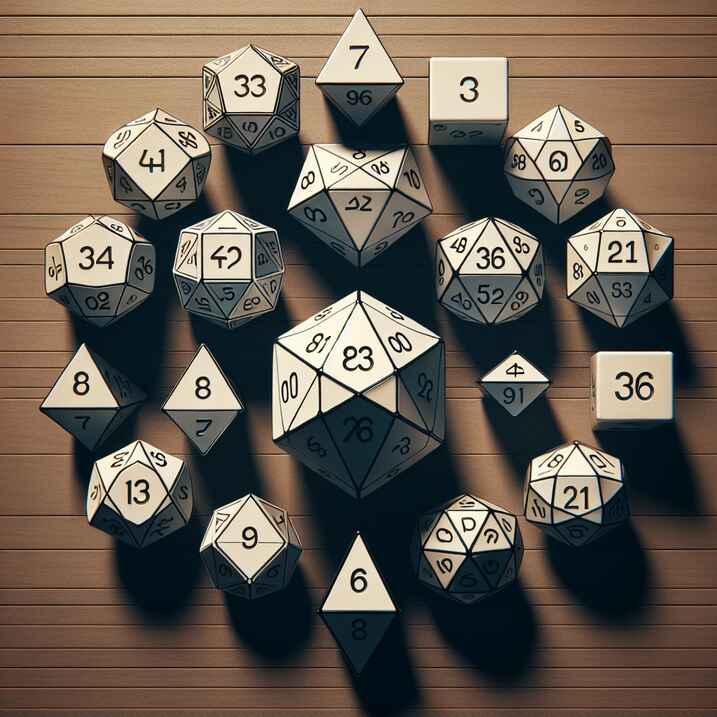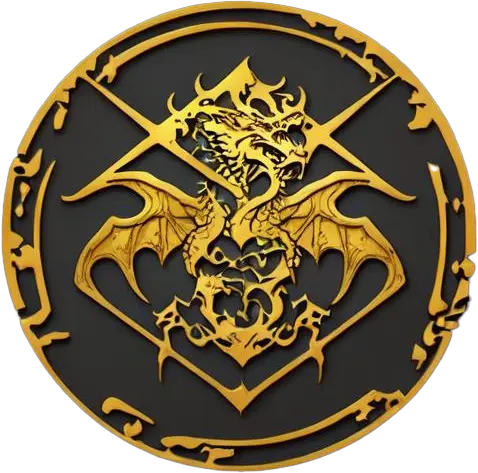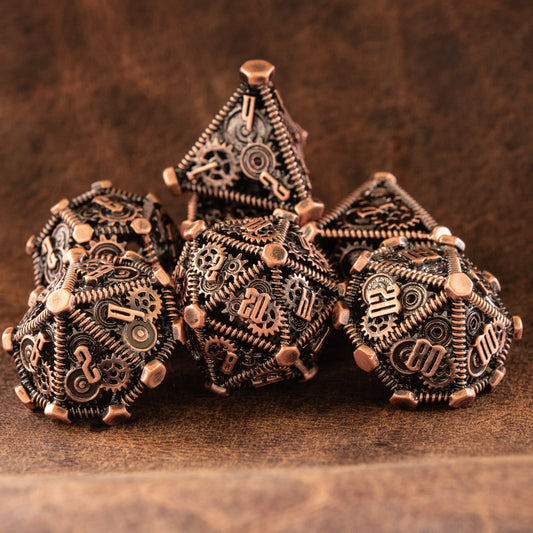
Everything You Need to Know About Polyhedral Dice
Share
Everything You Need to Know About Polyhedral Dice
Introduction
Ever wondered about those fascinating, multi-sided dice used in tabletop games? In this article, we'll delve into the world of polyhedral dice, exploring their types, uses, and significance in games like Dungeons & Dragons. These intriguing dice are not just for show; they play a pivotal role in the mechanics of many tabletop role-playing games (TTRPGs), adding layers of complexity and excitement to the gameplay.
What Are Polyhedral Dice?
Definition
Polyhedral dice are multi-sided dice used in various games, particularly in the realm of tabletop role-playing games like Dungeons & Dragons. Unlike the standard six-sided dice (d6) commonly found in board games, polyhedral dice come in multiple shapes and sizes, each with a different number of faces.
Historical Context
The history of polyhedral dice dates back to ancient civilizations, where they were used for gaming and divination. However, their modern incarnation in tabletop games began in the 1970s with the advent of Dungeons & Dragons. Since then, these dice have become a staple in the gaming community, evolving in design and material to enhance the gaming experience.
Materials of Polyhedral Dice
Polyhedral dice are crafted from various materials, each offering unique aesthetics and tactile experiences. Here are some common materials used:
Metal
Metal dice are high-end and robust, providing a satisfying weight and durability. They are often favored by serious gamers who appreciate their premium feel and longevity.
Plastic
Plastic dice are affordable and common, making them accessible to beginners and casual players. They come in a wide range of colors and designs, offering versatility and ease of use.
Resin
Resin dice are durable and visually appealing, often featuring intricate designs and vibrant colors. They strike a balance between affordability and aesthetics, making them a popular choice among gamers.
Stone
Stone dice are luxurious and unique, often handcrafted from semi-precious stones. They offer a distinctive look and feel, adding a touch of elegance to any dice collection.
Types of Polyhedral Dice
Polyhedral dice sets typically include seven different dice, each serving a specific purpose in gameplay. Let's explore the various types:
D4
- Shape: Tetrahedron
- Usage: The d4 is used for smaller weapon damage and certain spells. Its pyramid shape ensures that each face is equally likely to land face up.
D6
- Shape: Cube
- Usage: Common in board games, the d6 is used for medium weapon damage in TTRPGs. Its familiar shape makes it a versatile and frequently used die.
D8
- Shape: Octahedron
- Usage: The d8 is used for medium weapon damage and various spells. Its eight faces provide a broader range of outcomes compared to the d6.
D10
- Shape: Decahedron
- Usage: The d10 is used for larger damage rolls and percentile rolls. When paired with another d10, it can generate percentile results from 00 to 99.
D12
- Shape: Dodecahedron
- Usage: The d12 is used for larger weapon damage. Its twelve faces make it less common but crucial for certain powerful attacks and spells.
D20
- Shape: Icosahedron
- Usage: The d20 is the most critical die in Dungeons & Dragons, used for attacks, checks, and saving throws. Its twenty faces offer a wide range of potential outcomes, making it central to the game's mechanics.
D100
- Shape: Two D10s
- Usage: The d100 is used for determining odds and random events. By rolling two d10s, players can generate a result between 1 and 100, adding an element of chance to the game.
How to Use Polyhedral Dice in Games
Dungeons & Dragons
In Dungeons & Dragons, each type of polyhedral dice has a specific role. For example, the d20 is rolled to determine the success of an attack or skill check, while the d6 might be used to calculate damage from a fireball spell. The variety of dice ensures that every action and event in the game is governed by chance, adding unpredictability and excitement.
Other Tabletop Games
Polyhedral dice are not exclusive to Dungeons & Dragons. They are used in a myriad of other tabletop games, each with its own set of rules and mechanics. Games like Pathfinder, Shadowrun, and Call of Cthulhu also rely on these multi-sided dice to drive their narratives and outcomes.
Polyhedral dice are more than just colorful tools used to determine outcomes—they are an integral part of the gaming experience. Understanding the different types of dice and their uses can enhance your gameplay and deepen your immersion in the world of tabletop role-playing games. So, whether you're a seasoned adventurer or a fresh-faced newbie, it's time to roll the dice and embark on your next epic quest!
Choosing the Right Dice for Your Game
Selecting the perfect set of polyhedral dice can significantly enhance your gaming experience. Here's a guide to help you make an informed decision:
Considerations
Design
When choosing dice, consider their design. The color, theme, and overall aesthetic should resonate with your personal style or the character you're playing. Whether you prefer a classic look or something more vibrant and unique, there's a set out there that will match your taste.
Durability
Durability is another crucial factor. If you play frequently, you'll want dice that can withstand countless rolls. Metal and resin dice are known for their robustness, while plastic dice, though more affordable, might wear out faster with heavy use.
Material
The material of the dice can affect both their feel and performance. Metal dice offer a satisfying heft and longevity, resin dice are both durable and visually stunning, and plastic dice provide a budget-friendly option with a wide range of designs. Stone dice, though luxurious, are more fragile and should be handled with care.
Popular Dice Sets
There are numerous dice sets available on the market, each with its own unique features. Here are a few popular examples:
- Chessex Gemini Dice Set: Known for their vibrant, dual-color designs and affordability.
- Q-Workshop Steampunk Dice Set: Featuring intricate engravings and a steampunk theme, perfect for adding a touch of flair to your game.
- Wyrmwood Artisan Dice: Handcrafted from exotic woods and metals, these dice are a premium choice for serious collectors.
Digital vs. Physical Dice
In the modern age of gaming, players have the option to use either digital or physical dice. Each has its own set of advantages and disadvantages.
Digital Dice
Advantages
Digital dice are incredibly convenient, especially for virtual games. They eliminate the need for physical storage and can be integrated directly into online platforms like Roll20 or D&D Beyond. Additionally, digital dice rollers often come with features like automatic calculations and custom roll settings.
Disadvantages
However, digital dice lack the tactile experience of rolling physical dice. Many players find the physical act of rolling dice to be an essential part of the gaming experience, adding a tangible element of chance and excitement.
Physical Dice
Advantages
Physical dice are tangible, collectible, and visually appealing. They come in a variety of materials, colors, and designs, allowing players to express their personal style. Rolling physical dice also adds a sensory experience that many players find irreplaceable.
Disadvantages
On the downside, physical dice can be expensive, especially high-end sets made from metal or stone. They also require storage solutions to keep them organized and protected from damage.
Recommended Digital Dice Rollers
- D&D Beyond: Integrated with character sheets, making it easy to keep track of rolls and modifiers.
- Google Dice Roller: A quick and easy option for simple rolls.
- Roll Dice with Friends: Offers custom roll rooms for a more interactive experience.
How to Use Polyhedral Dice in Games
Dungeons & Dragons
In Dungeons & Dragons, polyhedral dice are essential for determining the outcomes of various actions. Each type of die has a specific role:
- D20: Used for attack rolls, skill checks, and saving throws.
- D12: Often used for damage rolls of larger weapons like greataxes.
- D10: Utilized for percentile rolls and certain damage calculations.
- D8: Commonly used for medium weapon damage and spell effects.
- D6: Versatile for both weapon damage and various game mechanics.
- D4: Used for smaller weapon damage and specific spells.
- D100: Employed for determining odds and random events through percentile rolls.
For example, when a player attacks an enemy, they roll a D20 to determine if the attack hits. If successful, they then roll the appropriate damage die (such as a D8 for a longsword) to calculate the damage dealt.
Other Tabletop Games
Polyhedral dice are not exclusive to Dungeons & Dragons. They are used in a variety of other tabletop games, each with its own unique mechanics. Games like Pathfinder, Shadowrun, and Call of Cthulhu also rely on these multi-sided dice to drive their narratives and outcomes. Understanding how to use polyhedral dice in these games can enhance your overall tabletop gaming experience.
Polyhedral dice are more than just colorful tools used to determine outcomes—they are an integral part of the gaming experience. By understanding the different types of dice and their uses, you can enhance your gameplay and deepen your immersion in the world of tabletop role-playing games.
Whether you prefer the tactile satisfaction of rolling physical dice or the convenience of digital dice rollers, there's a perfect set out there for you. So, dive into the world of polyhedral dice, explore the options, and choose the set that will accompany you on your next epic quest.
Call-to-Action
Ready to embark on your next adventure? Explore the wide range of polyhedral dice available and find the perfect set to elevate your game. Happy rolling!


